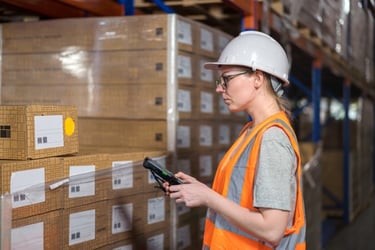Are you aware of the impact you and your business activities have on e-waste?
Consider your daily routine. How many different battery-powered or plug-in electrical objects do you use?
You may start your day with a wake-up alarm on a clock or smartphone. You switch on a bedside lamp and stumble into the bathroom to use an electric toothbrush. Perhaps you step on a set of bathroom scales that sync to an app on your phone.
You tell your smart home device to play your Monday motivation playlist to get you in the mood for the day ahead. The smartwatch on your wrist notifies you of your upcoming meetings. Your work phone vibrates to tell you the same.
Breakfast comes from the fridge and uses a toaster or a grill, maybe a stove if you’ve got the time (lucky you, enjoying that fry-up). You push a pod into the coffee machine or boil the kettle.
While you’re savoring that first bite, you open up your work emails or instant messages to see what’s going to demand your attention today.
You progress to the office where your laptop and monitor (maybe two or three!) await. A nudge or a click of the mouse wakes everything up and a keyboard is pounded with your password.
Before you’ve even consumed your first caffeine boost of the day, you’ve encountered 10 or more different electronics.
The figure grows when you start work.
Not all of those will be vital to your routine. People with higher standards of living and more disposable income will have more luxury electronics.
As science and engineering develop, so too does the technology that becomes commoditized. All those objects, the necessary and the unnecessary, have a life expectancy. At some point, you’ll look to seek a replacement, either because of a fault or because technology developments force it into obsolescence, and you’re driven to keep up with the Joneses.
This could be at home or at work, as you strive for the latest technologies to give you a competitive edge.
What happens to those electronics once you no longer need them? If you don’t formally recycle the goods through official and regulated channels, they will likely become e-waste.
Here at Ingram Micro Lifecycle we focus on extending the lifecycle of IT, mobility, and electronic equipment. We’re committed to the circular economy and in doing so, save hundreds of thousands of devices across the globe from becoming e-waste every year.
In the article below, we’ll look at the current state of e-waste, what the biggest culprits are, and the steps you can take to advance your ESG objectives in reducing your e-waste contributions.
What is e-waste?
It’s 2024 – over 20 years after the first Waste Electrical and Electronic Equipment Directive (WEEE Directive) was created and enforced in EU states. Since that time, you’ve probably already heard of e-waste.
In case you haven’t, e-waste is an object that houses a battery or has a plug that has been discarded. This includes:
- white goods
- gaming devices
- wearables
- smartphones
- laptops
- monitors
- and more
As our technology diversifies, so too does the e-waste. In the last few years, we’ve been able to add VR headsets and smart home devices, such as sound systems and video doorbells, to the list.
COVID saw a rise in the need for laptops, mobiles, and second screens to facilitate the shift to hybrid working. These were in addition to the equipment already placed in offices.
What will happen to the charging points for electric vehicles when they need to be updated?
As the make-up of the e-waste changes, the processes to efficiently manage it must also change. Your business needs to ensure that its e-waste management adapts to support the ebb and flow of electronics that it possesses.
Why is e-waste a problem?
The technological revolution began in the 70s. Very soon after that, there were used electronics that nobody needed that had to go somewhere. E-waste started to pile up.
It’s impossible to get an accurate figure on the tonnage of waste goods that litter the planet. Some countries don’t have the processes in place to report on this. Even if a process was to be put in place, years of e-waste is already present, unaccounted for.
The Roundup reports an estimated 347.18 million metric tonnes of unrecycled e-waste by the end of 2022. They also indicate a growth of 3.4% in the global generation of e-waste, taking the contribution for that year to 59.4 million metric tonnes. In 2019, this was around 54 million metric tonnes. By 2030, it’ll be around 74 million metric tonnes per year.
This electronic waste is toxic or hazardous to the environment if left to decay and break down.
Less than a fifth of all e-waste is recycled responsibly.
In the 1980s, two countries were found to be transporting e-waste to less developed countries. As a result, the Basel Convention was put up for the vote in 1989 and, in 1992, made it illegal to transfer hazardous waste between countries.
Despite this, some e-waste is still shipped to countries that lack the infrastructure, processes, or legislation to protect against unsafe e-waste handling. Others may have legislation but not enforcement.
In these countries, e-waste can be processed incorrectly, by open-air burning, through acid baths, and via personal handling of contaminants. This releases harmful substances such as lead, mercury, arsenic, and brominated flame retardants (BFRs). Sustained human contact with these can cause neurological damage and cancer, and CO2 is released into the atmosphere.
The damaging repercussions from informal and incorrect handling of e-waste can echo long after such practices are ceased.
What contributes to e-waste?
Consider how quickly you change your smartphone compared to your fridge, for example. The GSMA reports that the average use cycle of a smartphone is three years; however, the technical life can be up to 7 years. Most major appliances can last up to 15 years before a replacement is needed.
By weight, it’s unsurprising that the largest culprit of e-waste is small household electronics, such as microwaves, vacuum cleaners, kettles, etc.
Small IT equipment, such as mobile phones, is one of the smallest contributors. 77% of EU citizens would rather repair their electronics than buy new ones but ultimately discard them after being discouraged by the repair process.
There are many local scrap schemes and recycling centers that will take away your larger electronics and white goods. However, there’s an increase in driving consumers to recycle their smaller electronics. Instead of finding a new home for our mobiles and smaller gadgets, we’re prone to hiding them away in drawers and cupboards.
A WEEE Forum report published in 2022 stated that on average, households in the EU own 74 EEE (Electrical and Electronic Equipment), excluding lights. Together, it’s believed there are 7 million metric tonnes of electronics that are hoarded and working. 3 million metric tonnes are hoarded and broken. This hoarding is broken down into:
- Small IT equipment – 17%
- Small equipment – 14%
- Screens and monitors – 14%
- Large equipment – 9%
- Temperature exchange equipment – 8%
Another report stated that 5.3 billion smartphones would become waste in 2022, either being hoarded or heading to landfill.
3 million metric tonnes of electronics are broken and hoarded.
Think of the raw materials that were harvested to now sit idle. The components that could be used elsewhere. How many of these devices are sitting in your home?
What does e-waste mean for your business?
When you refresh your IT estate, you hopefully don’t put the old devices into cupboards! This poses a huge risk of theft of the physical devices and any lingering data on them.
There’s also an opportunity to recover any residual value from these devices if you will no longer have a use for them.
In light of the shift to more hybrid and remote working, mobility devices are preferred as they provide flexibility. Any unused desktop PCs may become redundant and destined for the scrap heap of e-waste. These need to be compliantly wiped of data and a recycling or demanufacturing partner found to recover materials.
There are also more laptops and monitors in circulation to enable more efficient remote work. An increase in devices = an increase in possible e-waste. What are your plans to manage this increase?
The e-waste figures are unavoidable. The message is getting out that action must be taken to stem the rising tide of e-waste.
Is circular economy right for you?
While not a silver bullet or a one-size-fits-all solution, changing from a linear economy to a circular one will reduce the generation of e-waste.
A circular economy will extend the lifecycle of products already manufactured and in circulation. Instead of buying new, we can switch to buying the technology that’s been through the repair and refurbishment process.
By buying used but reconditioned electronics, we cut back on the carbon emissions released as part of the manufacturing process. Thus cutting back not only on e-waste generation but helping the planet more by reducing gases harmful to the ozone.
These refurbished products will eventually reach the point where they can no longer be repaired or refurbished. At this point, the resultant e-waste needs to be disposed of correctly.
Take some time as you progress throughout your day- count how many sources of potential e-waste you use. Does the number shock you?
Consider switching to a more circular approach, not just at home but at work too.
Ingram Micro Lifecycle set out to enable a circular economy for our customers’ IT, mobility, and electronic equipment. Our array of solutions ensures that devices, where possible, are expertly restored to a near-new condition. Our Original Equipment Manufacturer (OEM) accreditations give us access to the best legitimate parts so products are in tip-top condition for as long as possible.
This means that as your partner, we’ll be reducing the e-waste your company generates – great for your ESG objectives. We’ll also recover value for you at the same time. Win-win!
Continue learning with these helpful resources








.jpg)


.jpg?width=450&height=250&name=used%20computer%20hardware%20in%20garbage%20(1).jpg)

